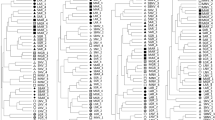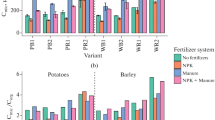Abstract
In a laboratory pot experiment, two mutant cultivars of sunflower (Helianthus annuus cv. r2p2 and Helianthus annuus cv. r5n1) were grown on soils with anthropogenic polyelemental anomalies and on a background control soil, and a comparative analysis of their rhizospheric microflora was carried out. The number of soil bacteria, actinomycetes, and micromycetes, as well as the number of rhizospheric microorganisms resistant to Zn2+, Pb2+, and Cu2+ ions, were estimated in the rhizosphere of sunflower cultivars. Quantitative changes in the sunflower rhizospheric microbocenoses formed under the influence of both the plant genotype and anthropogenic soil pollution, were revealed. A pronounced stimulation of the number of rhizospheric microorganisms of all groups studied in the plants that were cultivated on the anthropogenically contaminated soil from PJSC Kosogorsk Metallurgical Plant was found. In this case, cultivar differences were observed; namely, the maximal number of bacteria and actinomycetes was revealed in the rhizosphere of H. annuus cv. r2p2, while the maximal number of micromycetes was revealed in the rhizosphere of H. annuus cv. r5n1. An increased number of microorganisms resistant to lead ions was revealed in the rhizosphere of H. annuus cv. r2p2. The observed changes in the structure of rhizospheric microbial communities of the sunflower cultivars associated with the stimulation of the growth and activity of soil microflora, may be in demand for phytoremediation of anthropogenically contaminated soils.

Similar content being viewed by others
REFERENCES
Alaboudi, K., Ahmeda, B., and Brodie, G., Phytoremediation of Pb and Cd contaminated soils by using sunflower (Helianthus annuus) plant, Ann. Agricult. Sci., 2018, vol. 63, no. 1, pp. 123–127. https://doi.org/10.1016/j.aoas.2018.05.007
Ashraf, M.Y., Ashraf, M., Mehmood, K., Akhtar, J., Hussain, F., and Arshad, M., Phytoremediation of saline soils for sustainable agricultural productivity, in Plant Adaptation and Phytoremediation, Ashraf, M., Ozturk, M., and Ahmad, M.S.A., Eds., Dordrecht: Springer, 2010, pp. 335–355. https://doi.org/10.1007/978-90-481-9370-7_15
Bitjuckij, N.P., Mikroelementy i rasteniya (Trace Elements and Plants). St. Petersburg, St.-Peterburg. Univ., 1999.
Chirkin, L.A., Rentgenofluorestsentnyi analiz ob’’ektov okruzhayushchei sredy: Uchebnoe posobie (X-ray Fluorescence Analysis of Environmental Objects: Textbook), Vladimir: Vladimir. Gos. Univ., 2009.
Deng, S., Caddell, D., Yang, J., Dahlen, L., Washington, L., and Coleman-Derr, D., Genome wide association study reveals plant loci controlling heritability of the rhizosphere microbiome, BioRxiv, 2020, pp. 1–24. https://doi.org/10.1101/2020.02.21.960377
Dhiman, S.S., Zhao, X., Li, J., Kim, D., Kalia, V.C., Kim, I.-W., Kim, J.Y., and Lee, J.-K., Metal accumulation by sunflower (Helianthus annuus L.) and the efficacy of its biomass in enzymatic saccharification, PLoS One, 2017, vol. 12, e0175845. https://doi.org/10.1371/journal.pone.0175845
Drugov, Yu.S. and Rodin, A.A., Ekologicheskie analizy pri razlivakh nefti i nefteproduktov, prakticheskoe rukovodstvo (Environmental Analyzes for Oil and Oil Products Spills: A Practical Guide), Moscow: BINOM, 2017.
Fokina, A.I., Ashikhmina, T.Ya., Domracheva, L.I., and Gornostaeva, E.A., Heavy metals as a factor of metabolism change in microorganisms (review), Teor. Prikl. Ekol., 2015, no. 2, pp. 5–17.
GN 2.1.7.2041-06. Predel’no dopustimye koncentratsii (PDK) khimicheskikh veshhestv v pochve: Gigienicheskie normativy (GN 2.1.7.2041-06. Maximum Permissible Concentrations (MPCs) of Chemicals in the Soil: Hygienic Standards), Moscow: Federal. Tsentr Gigieny Epidemiologii Rospotrebnadzora, 2006.
GN 2.1.7.2511-09. Orientirovochno dopustimye kontsentratsii (ODK) khimicheskikh veshchestv v pochve: Gigienicheskie normativy (GN 2.1.7.2511-09. Approximate Permissible Concentrations (APCs) of Chemicals in the Soil: Hygienic Standards), Moscow: Federal. Tsentr Gigieny Epidemiologii Rospotrebnadzora, 2009.
GOST 26483-85. Pochvy. Prigotovlenie solevoi vytyazhki i opredelenie ee pH po metodu TsINAO (GOST 26483-85. Soils. Preparation of Salt Extract and Determination of Its pH by CINAO Method), Moscow: Izd. Standartov, 1985.
GOST 26488-85. Pochvy. Opredelenie nitratov po metodu TsINAO (GOST 26488-85. Soils. Determination of Nitrates by CINAO Method), Moscow: Izd. Standartov, 1985.
GOST 26489-85. Pochvy. Opredelenie obmennogo ammoniya po metodu TsINAO (GOST 26489-85. Soils. Determination of Exchangeable Ammonium by CINAO Method), Moscow: Izd. Standartov, 1985.
Govarthanan, M., Mythili, R., Selvankumar, T., Kamala-Kannan, S., and Kim, H., Mycophytoremediation of arsenic- and lead-contaminated soils by Helianthus annuus and wood rot fungi, Trichoderma sp. isolated from decayed wood, Ecotoxicol. Environ. Saf., 2018, vol. 151, pp. 279–284. https://doi.org/10.1016/j.ecoenv.2018.01.020
Grishko, V.N. and Syshchikova, O.V., Streptomyces communities in soils polluted with heavy metals, Eurasian Soil Sci., 2009, vol. 42, no. 2, pp. 217–224. https://doi.org/10.1134/S1064229309020136
Hemida, S.K., Omar, S.A., and Abdel-Mallek, A.Y., Microbial populations and enzyme activity in soil treated with heavy metals, Water, Air, Soil Pollut., 1997, vol. 95, nos. 1–4, pp. 13–22.
Joynt, J., Bischoff, M., Turco, R., Konopka, A., and Nakatsu, C.H., Microbial community analysis of soils contaminated with lead, chromium and petroleum hydrocarbons, Microb. Ecol., 2006, vol. 51, no. 2, pp. 209–219.
Kolbas, A., Mench, M., Herzig, R., Nehnevajova, E., and Bes, C.M., Copper phytoextraction in tandem with oilseed production using commercial cultivars and mutant lines of sunflower, Int. J. Phytoremediation, 2011, vol. 13, pp. 55–76. https://doi.org/10.1080/15226514.2011.568536
Kolesnikov, S.I., Popovich, A.A., Kazeev, K.Sh., and Val’kov, V.F., The influence of fluorine, boron, selenium, and arsenic pollution on the biological properties of ordinary chernozems, Eurasian Soil Sci., 2008, vol. 41, no. 4, pp. 400–404.
Kolesnikov, S.I. Ponomareva, S.V., Kazeev, K.Sh., and Valkov, V.F., Ranking of chemical elements according to the degree of their ecological danger to the soil, Dokl. Ross. S.-Kh. Akad. Nauk, 2010, no. 1, pp. 27–29.
Kötschau, A., Büchel, G., Einax, J.W., von Tümpling, W., and Merten, D., Sunflower (Helianthus annuus): phytoextraction capacity for heavy metals on a mining-influenced area in Thuringia, Germany, Environ. Earth Sci., 2014, vol. 72, no. 6, pp. 2023–2031. https://doi.org/10.1007/s12665-014-3111-2
Leff, J.W., Lynch, R.C., Kane, N.C., and Fierer, N., Plant domestication and the assembly of bacterial and fungal communities associated with strains of the common sunflower, Helianthus annuus, New Phytol., 2017, vol. 214, pp. 412–423. https://doi.org/10.1111/nph.14323
Lenart-Boroń, A. and Boroń, P., The effect of industrial heavy metal pollution on microbial abundance and diversity in soils—a review, in Environmental Risk Assessment of Soil Contamination, Hernandez-Soriano, M.C., Ed., Rijeka: InTech, 2014, pp. 759–783. https://doi.org/10.5772/57406
Marfenina, O.E., Antropogennaya ekologiya pochvennykh gribov (Anthropogenic Ecology of Soil Fungi), Moscow: Meditsina dlya vsekh, 2005.
Mench, M., Dellise, M., Bes, C.M., Marchand, L., Kolbas, A., Le Coustumer, Ph., and Oustriere, N., Phytomanagement and remediation of Cu-contaminated soils by high yielding crops at a former wood preservation site: sunflower biomass and ionome, Front. Ecol. Evol., 2018, vol. 6, article 123. https://doi.org/10.3389/fevo.2018.00123
Mortvedt, J.J., Heavy metal contaminants in inorganic and organic fertilizers, in Fertilizers and Environment, Rodriguez-Barrueco, C., Ed., Dordrecht: Kluwer, 1996, pp. 5–11.
Nehnevajova, E., Herzig, R., Bourigault, C.E., Bangerter, S., and Schwitzguebel, J.-P., Stability of enhanced yield and metal uptake by sunflower mutants for improved phytoremediation, Int. J. Phytoremediation, 2009, vol. 11, pp. 329–346. https://doi.org/10.1080/15226510802565394
OST 4641-76. Metody agrokhimicheskikh analizov pochv. Opredelenie podvizhnykh form fosfora i kaliya v pochvakh po metodu Chirikova v modifikatsii TsINAO (OST 4641-76. Methods for Agrochemical Soil Analysis. Determination of Mobile Forms of Phosphorus and Potassium in Soils by the Chirikov Method Modified by TsINAO), Moscow, 1976.
PND F 16.1:2:2.2:2.3:3.64-10. Metodika izmerenii massovoi doli nefteproduktov v probakh pochv, gruntov, donnyh otlozhenij, ilov, osadkov stochnyh vod, othodov proizvodstva i potrebleniya gravimetricheskim metodom (PND F 16.1:2:2.2:2.3:3.64-10. Methods for Measuring the Mass Fraction of Petroleum Products in Samples of Soils, Grounds, Bottom Sediments, Silts, Sewage Sludge, Production and Consumption Waste by the Gravimetric Method), Moscow: Federal’nyi tsentr analiza i otsenki tekhnogennogo vozdeistviya, 2010.
Praktikum po mikrobiologii (Workshop in Microbiology), Netrusov, A.I., Ed., Moscow: Akademiya, 2005.
Rizwan, M., Ali, S., Rizvi, H., Rinklebe, J., Tsang, D.C.W., Meers, E., Ok, Y.S., and Ishaque, W., Phytomanagement of heavy metals in contaminate soils using sunflower—a review, Crit. Rev. Environ. Sci. Technol., 2016, vol. 46, pp. 1498–1528. https://doi.org/10.1080/10643389.2016.1248199
Schlemper, T.R., Leite, M.F.A., Luccheta, A.R., Shimels, M., Bouwmeester, H. J., van Veen, J.A., and Kuramae, E.E., Rhizobacterial community structure differences among sorghum cultivars in different growth stages and soils, FEMS Microbiol. Ecol., 2017, vol. 93, no. 8, pp. 1–11. https://doi.org/10.1093/femsec/fix096
Schlemper, T.R., van Veen, J.A., and Kuramae, E.E., Co-variation of bacterial and fungal communities in different sorghum cultivars and growth stages is soil dependent, Microb. Ecol., 2018, vol. 76, no. 1, pp. 205–214. https://doi.org/10.1007/s00248-017-1108-6
Shirokikh, I.G., Solov’eva, E.S., and Ashikhmina, T.Y., Actinomycete complexes in soils of industrial and residential zones in the city of Kirov, Eurasian Soil Sci., 2014, vol. 47, no. 2, pp. 89–95. https://doi.org/10.1134/S1064229313100062
Singh, A. and Prasad, M., Reduction of heavy metal load in food chain: technology assessment, Rev. Environ. Sci. Biotechnol., 2011, vol. 10, no. 3, pp. 199–214. https://doi.org/10.1007/s11157-011-9241-z
Stroganova, M.N. and Agarkova, M.G., Urban soils: learning experience and systematics, Eurasian Soil Sci., 1992, no. 7, pp. 16–24.
Stroganova, M.N., Myagkova, A.D., and Prokof’eva, T.V., The role of soils in urban ecosystems, Eurasian Soil Sci., 1997, vol. 30, no. 1, pp. 82–86.
Tejeda-Agredano, M.C., Gallego, S., Vila, J., Grifoll, M., Ortega-Calvo, J.J., and Cantos, M., Influence of the sunflower rhizosphere on the biodegradation of PAHs in soil, Soil Biol. Biochem., 2013, vol. 57, pp. 830–840. https://doi.org/10.1016/j.soilbio.2012.08.008
Terekhova, V.A., Shitikov, V.K., Ivanova, A.E., and Kydralieva, K.A., Assessment of the ecological risk of technogenic soil pollution on the basis of the statistical distribution of the occurrence of micromycete species, Russ. J. Ecol., 2017, vol. 48, no. 5, pp. 417–424. https://doi.org/10.1134/S1067413617050125
Vremennye metodicheskie rekomendatsii po kontrolyu zagryazneniya pochv (Temporary Guidelines for the Control of Soil Pollution), Malakhov, S.G., Ed., Moscow: Gidrometeoizdat, 1984, part 2.
Zhang, X., Ma, M., Zhenzhen, W.U., Zhang, Z., Gao, R., and Shi, L., Effects of Helianthus annuus varieties on rhizosphere soil enzyme activities and microbial community functional diversity of saline-alkali land in Xinjiang, Acta Ecol. Sin., 2017, vol. 37, no. 5, pp. 1659–1666. https://doi.org/10.5846/stxb201510172095
Funding
This work was supported by the Russian Foundation for Basic Research (project no. 19-29-05257 “Technogenic Pollution of Soils with Toxic Elements and Possible Methods of Its Elimination”).
Author information
Authors and Affiliations
Corresponding authors
Ethics declarations
The authors declare that they have no conflict of interest. This article does not contain any studies involving animals or human participants performed by any of the authors.
Additional information
Translated by M. Batrukova
Rights and permissions
About this article
Cite this article
Muratova, A.Y., Zelenova, N.A., Sungurtseva, I.Y. et al. Comparative Study of the Rhizospheric Microflora of Sunflower Cultivars of Helianthus annuus (Asteraceae, Magnoliópsida) Grown on Soils with Anthropogenic Polyelemental Anomalies. Biol Bull Russ Acad Sci 48, 1904–1911 (2021). https://doi.org/10.1134/S1062359021100198
Received:
Revised:
Accepted:
Published:
Issue Date:
DOI: https://doi.org/10.1134/S1062359021100198




